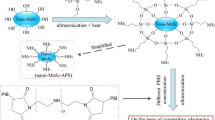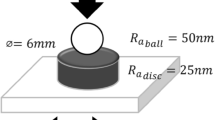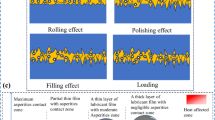Abstract
The foremost aim of the present work is to investigate the relationship between the thickness of the tribofilm formed and the tribological performance of palm oil based lubricant enriched by molybdenum disulphide (MoS2) nanoparticles. The experiment was carried out by pin-on-disk tribotester attached with electric contact resistance function conducted under boundary lubrication regime. The worn surface of specimen was characterized by scanning electron microscopy (SEM) coupled with energy dispersive X-ray spectroscopy (EDS) and surface profiler. The results indicate that PKO + MoS2 nanolubricant displayed a significant improvement in friction reduction and anti-wear performance; showing a 49.5% reduction in coefficient of friction and 46.1% wear scar diameter, compared to the base lubricant. Concurrently, the thickness of tribofilm was increased by 3.7% than that of base lubricant.
Access provided by Autonomous University of Puebla. Download conference paper PDF
Similar content being viewed by others
Keywords
1 Introduction
The last few decades have witnessed a vast research on nanolubricants (a suspension of nanometre-sized solid particles in lubricant) as a result of growing environmental concerns and the continuous need for improving machinery’s efficiency. Recently, enormous efforts have been made on achieving a balance between safeguarding the environment and improving the tribological performance of the transportation sector [1, 2]. Vegetable oils have been gaining considerable attention as an alternative lubricant to replace the petroleum-based lubricant since they have shown remarkable advantages in terms of biodegradability and non-toxicity [3,4,5].
The development of alternative lubricants must not only consider environmental legislation; it also must meet increasing demands for fuel economy and durability by providing excellent tribological performance. The addition of additives in base lubricants can improve the tribological performance of lubricants. Friction modifiers, anti-wear and extreme pressure additives are amongst the most important additives used in an engine oil formulation [6]. In order to meet all of the aforementioned criteria, there is a need to reduce or eliminate the usage of traditional anti-friction and anti-wear additives such as organic polysulphides, phosphates, dithiophosphates, dithiocarbamates, molybdenum disulphide, zinc dialkyl-dithiophosphate (ZDDP), etc. and replace them with new types of non-toxic additives [7].
Molybdenum disulphide (MoS2) has gained popularity for the last two decades as additives in lubricant owing to the unique characteristics. The literature on using MoS2 nanoparticles as lubricant additives were reported to greatly improved the tribological performance of vegetable base and mineral base lubricants [8,9,10,11,12,13,14,15,16,17]. Previous studies state the following mechanisms involved: (1) The lamellar layer structure makes MoS2 possess low shear strength, (2) mending mechanism, and (3) formation of tribofilm. The dominant mechanism involved in the enhancement of friction reduction and anti-wear performance was the formation of tribofilm [8, 12, 13, 16,17,18].
However, limited experimental investigations have been carried out to direct monitor the tribofilm formation of MoS2 nanoparticles in vegetable oil base lubricant during sliding. This investigation was useful to clarify the relationship between the thickness of the tribofilm formed and the tribological performance of nanolubricant. Thus, this research was conducted to shed light on the relationship between the thickness of the tribofilm formed and the tribological performance. Here, we utilized MoS2 nanoparticles as additives in palm oil base lubricant and commercial engine oil SAE40 was used as benchmark lubricant for this study. The tribological performance of nanolubricants was evaluated using pin-on-disk tribotester equipped with electric contact resistance (ECR) to measure the formation of the tribofilm during the test.
2 Experimental Works
This research used RBD palm kernel oil (PKO) as the base lubricant because of its biodegradability, non-toxicity, and environment-friendly behaviour [19, 20]. MoS2 nanoparticles were commercially purchased from MK Impex Corporation, Canada. Commercial engine oil (SAE40) was used as a benchmark in the current research. MoS2 nanoparticles were dispersed in the base lubricant at 0.05 wt.% using a high shear homogeniser at 13000 rpm for 45 min.
The tribological performance of the tested lubricants was evaluated using pin-on-disk tribotester in accordance to ASTM G99, simulate for pure sliding contact. Pin-on-disk tribotester was equipped with electrical contact resistance (ECR) for clarification of wear mechanisms and verify the tribofilm formation of lubricant during sliding. For metal to metal contact, the contact potential across the disk is at maximum value of 100%, whereas when there is no surface contact between pin and disk, the contact potential value will drop to 0%.
In the present research, the material used for tribological tests using pin-on-disk tribotester is made up of stainless steel (SS304) as pin and SKD11 tool steel as disk. The tribological test was carried out at 9.8 N and sliding speed of 1 m/s under room temperature for 60 min duration. Only a little amount (4 ml) of lubricant was dropped at the interface to produce severe wear conditions. The experiment was conducted under lubricant starvation conditions to confirm the effectiveness of the role of nanoparticles as lubricant additives [2].
Prior to the worn surface analysis, the pin specimens were cleaned with acetone. The worn surfaces of the specimens was analysed using scanning electron microscopy (SEM) coupled with energy dispersive x-ray spectroscopy (EDS) and a surface profiler. These techniques give information on the morphology of the worn surfaces, elemental composition and surface roughness, respectively.
3 Results and Discussion
3.1 Friction and Wear Performance
Coefficient of friction (COF) and wear scar diameter (WSD) of the specimens lubricated with SAE40, PKO and PKO + MoS2 nanolubricant are presented in Fig. 1. Figure 1(a) shows the average COF of PKO was 9.6% lower than those of SAE40 (0.156). As shown in Fig. 1(a), a huge reduction in friction was achieved when the rubbing surfaces were lubricated with PKO + MoS2 nanolubricant, showing a reduction of 49.5% and 54.4% compared to that of PKO and SAE40, respectively. Due to its lamellar structure, MoS2 was able to provide easy interlayer sliding, thereby reduce the friction [12, 15, 17].
Figure 1(b) shows that the WSD of PKO was higher up to 12.6% than that of SAE40. The obtained results clearly show that PKO provide lower friction as boundary lubricant than that of SAE40, however it provide higher wear. Similar results were reported in previous investigations which found vegetable oils have a lower friction and higher wear [21,22,23]. The WSD obtained for PKO + MoS2 nanolubricant was 46.1% and 39.3% lower than that of PKO and SAE40, respectively. This finding provides evidence that MoS2 plays a positive role on the anti-wear performances of pure base lubricant.
Figure 2 plots the tribofilm formation curves measured by ECR of SAE40, PKO and PKO + MoS2 nanolubricant. Figure 2 clearly shows that ECR value for all tested lubricant were reached greater than 70%, indicated higher number of asperity contact as the present study conducted under boundary lubrication regime. The ECR value of PKO (74.8%) appeared higher than that of SAE40 (73.2%), indicating PKO form thinner tribofilm during sliding compared to that of mineral oil. This finding justifies PKO have higher wear than that of SAE40. Moreover, Fig. 2 shows that when MoS2 nanoparticles were added, a reduction in ECR by 3.7% could be observed which reflect PKO + MoS2 nanolubricant form thicker tribofilm than that of PKO base lubricant. This has led to the decreased in asperity contacts, resulting in reduction in wear. This fact verifies the improvement in tribological performance of PKO + MoS2 nanolubricant.
3.2 A Subsection Sample
The measured arithmetic average surface roughness (Ra) of the worn surface lubricated with SAE40, PKO and PKO + MoS2 nanolubricant are shown in Fig. 3. The obtained Ra value of the pin surface lubricated with PKO was 1.1% lower than that of SAE40. Interestingly, the surface roughness was significantly reduced by 85.9% when MoS2 nanoparticles were added into the PKO base lubricant. The reduction in the surface roughness was credited to the nanoscale dimension of MoS2 nanoparticles that can fill in the scars and grooves on the surfaces to reduce the direct asperities contact thereby reducing the surface roughness, this phenomenon also called as mending mechanism [9, 10].
Figure 4 shows the SEM images of the worn surface after test. The SEM images shown in Fig. 4(a) and (b) demonstrated deeper grooves, severe abrasion and delamination of worn surface lubricated with SAE40 and PKO, respectively. The wear-related debris particles results in abrasive mechanism, thus generates deeper grooves and severe abrasion on the sliding surfaces [24]. The presence of delamination on the worn surfaces indicated the wear mechanism involved is severe adhesion [25, 26]. It can be seen from the worn surface lubricated with PKO + MoS2 nanolubricant in Fig. 4(c), less damaged on the worn surface with smoother and shallower groove can be observed which also in line with lower surface roughness obtained. It is evident that adding MoS2 nanoparticles to the PKO base lubricant can effectively protect the surfaces against wear. MoS2 nanoparticles probably enter the contact area during sliding and formed thicker tribofilm on the worn surfaces thereby reduce metal to metal contact.
Table 1 shows the elemental composition on the worn surfaces of the pin samples obtained from EDS analysis. As shown in Table 1, it is evident that the amount of C element content on the worn surface lubricated with PKO + MoS2 nanolubricant was higher than that of SAE40 and PKO lubricants. This illustrates that more fatty acid molecules adsorb or remained on the steel surface to provide lubrication. The lower amount of O element also was detected on the worn surface lubricated with PKO + MoS2 nanolubricant indicating that the surface oxidation was lesser than that of SAE40 and PKO. In addition, the EDS analysis verifies the presence of high Mo element content on the worn surface. The presence of Mo element provides evidence that the MoS2 nanoparticles enter the contact area during sliding and deposited on the worn surface to form a protective tribofilm. The formation of thicker tribofilm was considered the main reason why the PKO + MoS2 nanolubricant was able to offer a significant protection against friction and wear compared to that of base lubricant. Therefore, the present investigation proves the key relationship between the thicknesses of tribofilm formation with the tribological performance.
4 Conclusion
From the present research, it has been found that the addition of MoS2 nanoparticles as additives results in significant improvement in the tribological performance of palm oil base lubricant. A COF drop by 49.5%, WSD lessen by 46.1% and a remarkable reduction in surface roughness by 85.9%, as compared to PKO base lubricant. The ECR technique was used to quantitatively monitor the tribofilm formation during sliding. The results show that the tribofilm thickness of PKO + MoS2 nanolubricant was 3.7% higher than that of PKO base lubricant. The current research confirmed that the dominant mechanism involved in the improvement of tribological performance of MoS2 nanolubricant under boundary lubrication was the tribofilm formation.
References
Alazemi, M.K.A., et al.: MoS2 nanolayer coated carbon spheres as an oil additive for enhanced tribological performance. Carbon 110, 367–377 (2016). https://doi.org/10.1016/j.carbon.2016.09.047
Ali, M.K.A., Xianjun, H., Mai, L., Qingping, C., Turkson, R.F., Bicheng, C.: Improving the tribological characteristics of piston ring assembly in automotive engines using Al2O3 and TiO2 nanomaterials as nano-lubricant additives. Tribol. Int. 103, 540–554 (2016)
Syahrullail, S., Azwadi, C.S.N., Ing, T.C.: The metal flow evaluation of billet extruded with RBD palm stearin. Int. Rev. Mech. Eng. 5(1), 21–27 (2011)
Golshokouh, I., Syahrullail, S., Ani, F.N., Masjuki, H.H.: Investigation of palm fatty acid distillate oil as an alternative to petrochemical based lubricant. J. Oil Palm Res. 26(1), 25–36 (2014)
Rasep, Z., Yazid, M.N.A., Samion, S.: A study of cavitation effect in a journal bearing using CFD: a case study of engine oil, palm oil and water. Jurnal Tribologi 28, 48–62 (2021)
Trindade, E.D., Zuleta Durango, A., Sinatora, A.: Friction and wear performance of MoDTC-containing and ester-containing lubricants over steel surfaces under reciprocating conditions. Lubric. Sci. 27(4), 217–229 (2015)
Rasheed, A.K., Khalid, M., Javeed, A., Rashmi, W., Gupta, T.C.S.M., Chan, A.: Heat transfer and tribological performance of graphene nanolubricant in an internal combustion engine. Tribol. Int. 103, 504–515 (2016)
Hu, K.H., Liu, M., Wang, Q.J., Xu, Y.F., Schraube, S., Hu, X.G.: Tribological properties of molybdenum disulfide nanosheets by monolayer restacking process as additive in liquid paraffin. Tribol. Int. 42(1), 33–39 (2009)
Rahmati, B., Sarhan, A.A., Sayuti, M.: Morphology of surface generated by end milling AL6061-T6 using molybdenum disulfide (MoS2) nanolubrication in end milling machining. J. Clean. Prod. 66, 685–691 (2014)
Golshokouh, I., Golshokouh, M., Ani, F.N., Kianpour, E., Syahrullail, S.: Investigation of physical properties for jatropha oil in different temperature as lubricant oil. Life Science J. 10(8s) (2013)
Golshokouh, I., Syahrullail, S., Ani, F.N., Masjuki, H.H.: Investigation of palm fatty acid distillate as an alternative lubricant of petrochemical based lubricants, tested at various speeds. Int. Rev. Mech. Eng. 7(1), 72–80 (2013)
Xie, H., Jiang, B., He, J., Xia, X., Pan, F.: Lubrication performance of MoS2 and SiO2 nanoparticles as lubricant additives in magnesium alloy-steel contacts. Tribol. Int. 93, 63–70 (2016)
Zhao, J., He, Y., Wang, Y., Wang, W., Yan, L., Luo, J.: An investigation on the tribological properties of multilayer graphene and MoS2 nanosheets as additives used in hydraulic applications. Tribol. Int. 97, 14–20 (2016)
Srinivas, V., Thakur, R.N., Jain, A.K.: Antiwear, antifriction, and extreme pressure properties of motor bike engine oil dispersed with molybdenum disulfide nanoparticles. Tribol. Trans. 60(1), 12–19 (2017)
Wang, Y., et al.: Processing characteristics of vegetable oil-based nanofluid MQL for grinding different workpiece materials. Int. J. Precis. Eng. Manuf. Green Technol. 5(2), 327–339 (2018)
Mushtaq, Z., Hanief, M.: Enhancing the tribological characteristics of Jatropha oil using graphene nanoflakes. Jurnal Tribologi 28, 129–143 (2021)
Chen, Z., Liu, Y., Gunsel, S., Luo, J.: Mechanism of antiwear property under high pressure of synthetic oil-soluble ultrathin MoS2 sheets as lubricant additives. Langmuir 34(4), 1635–1644 (2018)
Azman, N.F., Samion, S.: Dispersion stability and lubrication mechanism of nanolubricants: a review. Int. J. Precis. Eng. Manuf. Green Technol. 6(2), 393–414 (2019)
Kiu, S.S.K., Yusup, S., Soon, C.V., Arpin, T., Samion, S., Kamil, R.N.M.: Tribological investigation of graphene as lubricant additive in vegetable oil. J. Phys. Sci. 28, 257 (2017)
Yahaya, A., Samion, S., Musa, M.N., Skudai, U.T.M.: Determination of friction coefficient in the lubricated ring upsetting with palm kernel oil for cold forging of aluminum alloys. Jurnal Tribologi 25, 16–28 (2020)
Jabal, M.H., Ani, F.N., Syahrullail, S.: The tribological characteristic of the blends of Rbd palm olein with mineral oil using four-ball tribotester. Jurnal Teknologi 69(6), 3232 (2014). https://doi.org/10.11113/jt.v69.3232
Sapawe, N., Samion, S., Zulhanafi, P., Nor Azwadi, C.S., Hanafi, M.F.: Effect of addition of tertiary-butyl hydroquinone into palm oil to reduce wear and friction using four-ball tribotester. Tribol. Trans. 59(5), 883–888 (2016)
Hassan, M., Ani, F.N., Syahrullail, S.: Tribological performance of refined, bleached and deodorised palm olein blends bio-lubricants. J. Oil Palm Res. 28(4), 510–519 (2016)
Ali, M.K.A., Hou Xianjun, F.A., Essa, M.A.A., Abdelkareem, A.E., Sharshir, S.W.: Friction and wear reduction mechanisms of the reciprocating contact interfaces using nanolubricant under different loads and speeds. J. Tribol. 140(5), 720 (2018). https://doi.org/10.1115/1.4039720
Liu, X., Wang, L., Xue, Q.: A novel carbon-based solid–liquid duplex lubricating coating with super-high tribological performance for space applications. Surf. Coat. Technol. 205(8–9), 2738–2746 (2011)
Syahrullail, S., Hariz, M.A.M., Hamid, M.A., Bakar, A.A.: Friction characteristic of mineral oil containing palm fatty acid distillate using four ball tribo-tester. Procedia Engineering 68, 166–171 (2013)
Acknowledgement
The authors would like to express their thanks to the Ministry of Higher Education of Malaysia for the FRGS Grant (FRGS/1/2018/TK03/UTM/02/14), Universiti Teknologi Malaysia (UTM) for the Research University Grant (21H50), TDR Grant (05G23) and FRGS Grant (5F074, 5F173).
Author information
Authors and Affiliations
Corresponding author
Editor information
Editors and Affiliations
Rights and permissions
Copyright information
© 2022 The Author(s), under exclusive license to Springer Nature Singapore Pte Ltd.
About this paper
Cite this paper
Farhanah, A.N., Syahrullail, S., Hamid, M.K.A., Musa, M.N., Zawawi, F.M. (2022). The Tribofilm Formation of MoS2 Nanolubricant in Boundary Lubrication Regime. In: Samion, S., Abu Bakar, M.A., Kamis, S.L., Sulaiman, M.H., Mohd Zulkifli, N.W. (eds) Proceedings of the 3rd Malaysian International Tribology Conference. MITC 2020. Lecture Notes in Mechanical Engineering. Springer, Singapore. https://doi.org/10.1007/978-981-16-9949-8_2
Download citation
DOI: https://doi.org/10.1007/978-981-16-9949-8_2
Published:
Publisher Name: Springer, Singapore
Print ISBN: 978-981-16-9948-1
Online ISBN: 978-981-16-9949-8
eBook Packages: EngineeringEngineering (R0)








